Tuesday, June 3, 2008
Article #6
14th April 2008
Construction activity in Victoria is being threatened by an acute shortage of skilled workers, which is pushing up the costs of commercial and residential projects and exacerbating the housing affordability crisis.
The Master Builders Association of Victoria (MBA) believes that to keep pace with the industry's growth, Victoria needs 40,000 more skilled workers over the next five years.
A survey of commercial builders by the peak body has found that recruiting a skilled workforce was the biggest issue preventing the sector from reaching its potential.
The MBA is supporting calls for more State Government action to address skills shortages.Executive director Brian Welch said the survey highlighted the need for Victoria not only to retain its skilled professionals but also to attract new workers.
"With an ageing workforce and many of our senior building professionals close to retirement age, the situation is expected to worsen," Mr Welch said.
He said the problem was forcing up the costs for builders, and that this would feed into property prices for consumers.
"The fewer trades contractors there are to do work, then clearly prices will rise as shortages become imminent, so we are underbuilding as it stands and there are a lot of people over the next five years who will retire from the building industry."
Housing affordability in Australia has worsened over the past few years with home owners and renters spending more of their income on mortgage or rent payments.
According to figures collected by the Reserve Bank and the Bureau of Statistics, housing affordability fell to a 20-year low at the end of 2007.
Mr Welch said to address the skills shortage, the State Government should introduce several measures, including retraining skilled workers at retirement age so their skills and experience can be kept as "registered trainers".
"Master Builders is (also) calling on the Government to fund a study into why apprentices are bailing out of apprenticeships before completion," he said.
According to the Office of Training and Tertiary Education, in 2006 there was an increase of just 2% in apprenticeship commencements, but a 5.3% increase in cancellations and withdrawals.
Other key findings of the survey showed that 46% of those polled said it was very difficult to recruit highly skilled workers such as project managers and site managers.
More than half said the greatest difficulty was found in recruiting shop draftsmen.
ANALYSIS:
This article gives details as to the current skills shortage and the problems we are likely to face because of these shortages in the near future. The MBA has said that Victoria will need an extra 40,000 extra skilled workers over the next five years which means there will be a massive turnover of experienced skilled workers retiring as a new batch of young skilled persons try to fill the hole. However even with the drop in experience it is unlikely that 40,000 workers will be found in that time which of course means construction costs will go up as they’re skills are now more valuable. This rise in costs will be passed on to consumers who are already in a bad place with housing costs, as recently released figures show housing affordability has fallen to a 20 year low at the end of 2007. The only other option other than taking the inflated prices on the chin is to recruit workers from overseas, however this also has its downfalls. All in all the article explains there will be bumpy times ahead for people wanting to build or renovate their homes, at least until the new generation of skilled workers arrives.
Construction site # 4 - Edgewater apartments
 An overall shot of the site
An overall shot of the site

Here we can see a crane moving a pre cast panel accross the site. Also we are able to see under the top floor, which includes floor joists and bearers.

A worker helping place the pre cast panels after they are craned up to the top floor of the construction.
Construction site #3 - House construction

An overall shot of the site

Another overall shot, showing timber being stored neatly as well as left over earth from excavation that may be used later in construction.

A close up of one of the earlier mentioned concrete stumps with a steel bar comming out of the top to help join and secure the flooring after the concrete has been poured.
A close up of the brick vaneer. We can see a pier on the inside of the wall as well as what looks like a brick tie comming out the top.
Monday, June 2, 2008
Article #5
16th May 2008
(http://www.ferret.com.au/c/WorkSafe-Victoria/WorkSafe-Victoria-warns-against-working-in-close-proximity-to-mobile-plants-n776627)
WorkSafe Victoria has warned against working in close proximity to mobile plant after a worker’s leg was broken at Narre Warren.WorkSafe Victoria’s investigation is at an early stage, but it is understood the Mulgrave man was carrying out maintenance work at the bottom of a three-metre deep pit when he was struck by the bucket of an excavator. The pit was part of stormwater management infrastructure.WorkSafe Victoria’s Construction and Utilities Director, Chris Webb said working near mobile plant was a high risk activity, particularly when in confined spaces. “If something goes wrong there is little margin for error and the consequences, as in this case, can be serious.”
It took several hours to rescue the injured man because of safety concerns. The CFA set up a tripod and winched rescuers down to help him out.Chris Webb said that this incident should prompt a review of safety measures in all workplaces.“Most deaths and injuries occur where people are doing what are, for them, routine tasks.”WorkSafe Victoria’s experience is that the incident that kills or leaves a permanent injury is not much different from one you can walk away from. Surviving a day at work should not be a matter of luck, but the result of consistent good practice and job-planning.“Safe workplaces are created and maintained as a result of regular safety reviews, discussion about known and potential hazards and the implementation of safety management plans,” Chris Webb said.“Employers, including labour hire firms, sub-contractors and primary contractors have obligations, as do individuals and those who commission work.”
ANALYSIS:
This article explains that Work Safe is investigating the risks of working near mobile plant especially in confined spaces after a man broke his leg in a related incident. The main concern here is that using mobile plant may seem routine and simple but in a confined space one small error could mean a serious injury or even a death. The article explains that the current injury to a Narre Warren man should not be seen as a once off but should be a warning that the safety codes in this area need to be reviewed to straighten any problems out. This is a smart move by Work safe, however seems to only be precautionary at this point, however its better to be safe than sorry in these cases. Working in confined spaces is always a dangerous especially with mobile plant around and this current injury in Narre Warren shows how easy it is for things to go wrong and is a clear message to always take the necessary planning and precautions before you start working on any job.
Article #4
3rd May 2008
(www.buildingcommission.com.au)
Following today’s launch of Make Your Home Green, Victorians can access an online resource to reduce energy, save water, save money, reduce waste and improve health.
The launch at CEREs Community Environment Park coincided with the launch of new energy efficiency laws for home alterations and relocations.
Building Commissioner, Tony Arnel, launched the Brumby Government’s sustainability initiatives at the onsite 3AW Big House radio program. He also took part in a demonstration of Make Your Home Green.
“After experiencing Make Your Home Green I can see how beneficial this resource is going to be for Victorian households who want to reduce their carbon footprint,” Mr Arnel said.
“Make Your Home Green and new energy efficiency laws, which came into effect in the Building Code of Australia on 1 May 2008, were important steps towards reducing Victorian households’ greenhouse gas emissions.
“With 40,000 homes anticipated to be renovated, extended or relocated annually, the new energy efficiency laws for the building fabric of home alterations will further reduce greenhouse gas emissions while delivering greater comfort and lower energy costs to Victorians.”
All alteration and relocation work that requires a building permit is subject to the new energy efficiency laws. The laws apply to the thermal performance of a home (a 5 Star performance rating for the external walls, floors and roofs of your home) and do not require a solar hot water system or a rainwater tank for toilet flushing, as is the case with a new home. These changes bring Victoria in line with national standards.
Victorians who plan to build a new home, extend or renovate should contact a building designer, architect, builder or building surveyor for advice on 5 Star compliance. Information is also available at the Building Commission on 1300 360 380, or visit www.buildingcommission.com.au.
Make Your Home Green is a first for the building and plumbing industry and supports the Victorian Government’s commitment to create sustainable options for Victorians in the built environment. It is hosted and sponsored by the Building Commission and the Plumbing Industry Commission.
ANALYSIS:
This article is focused on the launch of Make Your Home Green as well as the new energy efficiency laws brought in today. The article explains how the new laws will help to reduce our carbon footprint whilst also saving money on energy, as Tony Arnel says “with 40,000 homes anticipated to be renovated, extended or relocated annually, the new energy efficiency laws for the building fabric of home alterations will further reduce greenhouse gas emissions while delivering greater comfort and lower energy costs to Victorians.” The new laws now bring Victoria in line with national standards which is a good step, however this should not be the end of trying to be innovative in this area as it is crucial that we continue to evolve more environmentally friendly methods of construction. This article will hopefully help people see that although the original cost is greater when you go ‘green’ it will eventually pay itself off in time, which may encourage more people to take the environmentally friendly path when building their new homes.
Construction site visit #1 - Car wash
The car wash that’s under construction on an ex-residential site off Geelong hwy is made up of 5 concrete walls dividing the areas for cars to pull into and be washed. We can see reinforcement bars poking out of the top of the columns at either end of the walls for added support and strength as well as being used to secure the roof to the wall. Lastly beams are running across the top to help keep the walls from moving inwards or outwards and to help further support the roof.


Next we can see they are preparing to put the roof on. The walls are set into place and the roof support structure is ready to be lifted on.
 Again we can see the roof structure on the ground; however we also see that guard rails have been put into place meaning they are planning to lift the roof on soon.
Again we can see the roof structure on the ground; however we also see that guard rails have been put into place meaning they are planning to lift the roof on soon.
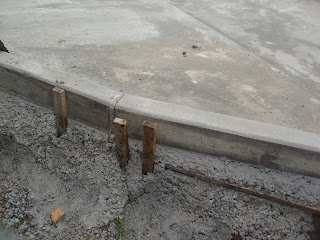
A couple of pictures of markers that act as a border for the concrete slab.
 Lastly a close up of the reinforcement used in the concrete columns. We can also see the beam across the top of the walls.
Lastly a close up of the reinforcement used in the concrete columns. We can also see the beam across the top of the walls.
Article #3
1st April 2008
(http://www.construction-innovation.info/index.php?id=38)
Two new publications from the Wayfinding in the Built Environment project are now available to help designers, developers, property owners and managers to create a more accessible and inclusive built environment. The project has focused on identifying technologies and systems that can make it easier and safer for people who
have a sensory impairment, particularly a vision impairment, to find their way around large public areas. Led by the Cooperative Research Centre (CRC) for Construction Innovation, the three-stage research project has involved an industry partnership of the public and private sectors working together with a national research team.
The design guidelines outline a design method to wayfinding, including technologies,
solutions and strategies. It identifies universal wayfinding design principles and includes an audit checklist template which can be customised for gathering information on buildings and surrounds. The resource is applicable to new buildings and their immediate surrounding spaces and upgrades of existing buildings.
Building commissioner Tony Arnel says: "A wayfinding system is a lot more than just signs - it encompasses aspects like architecture, landscape architecture, interior design, lighting and landmarks. There are also universal applications for wayfinding design principles that take into consideration people who are less mobile, the elderly and those with a low level understanding of written English." The Wayfinding resourcescan be found at the Construction Innovation website at www.construction-innovation. info and is free of charge.
ANALYSIS:
This article shows us the benefits of using a wayfinding system. This system properly designed, integrates with surrounding architecture, landscape, interior design and lighting, making it easier for people to access and understand environments. It also needs to be coordinated with other surrounding communications so the signage system can communicate clearly and run smoothly. The article above explains how wayfinding systems are becoming more and more usefull on construction sites and are helping to expand our workforce as Tony Arnel mentions. By using the wayfinding system people who are less mobile, with a low understanding of English or elderly can get around sites much easier and safer which is why more and more construction sites are using them.
Article #2
(http://www.safetowork.com.au/articles/Campaign-for-healthier-workforce_z166536.htm)
WORKSAFE Victoria has established a program to cut health costs, absenteeism, injuries and disease and the risk of chronic disease in Victorian workers.According to the authority, Victoria is a safe place to work, but the workforce is becoming unhealthy and thus more likely to be injured at work.
The WorkHealth program will see professional health providers visiting small and medium companies and regional centres to provide free screening and advice.The state government will provide $600m to the program over five years, and large employers will be eligible for dollar-for-dollar grants to provide screening and advice. Programs for the most at-risk workers will also be implemented.Statistics provided by the authority show four million days were lost by Australian workplaces in 2001, due to conditions arising from workers lacking in physical exercise and having poor nutrition. Annually, the state’s lost productivity cost more than $440m.
The authority is especially concerned with the risk of chronic diseases such as Type 2 diabetes, cardiovascular disease and cancer. Risk factors include poor diet, inactivity, smoking, alcohol misuses, excess weight, high blood pressure and high cholesterol intake.According to WorkSafe, this latest campaign will emphasise the often-neglected “health” part in occupational health and safety.
ANALYSIS:
This article shows us that the current work force in Victoria is becoming unhealthy and thus more likely to be injured at work. This is becoming more and more of a problem and as the article explains, more than four million days were lost due to issues with health, which equates to $440 million. In a bid to rectify the problem the WorkHealth program will be starting a $600m program which sends professional health providers to small and medium companies for free screening and advice. This is another good decision from WorkSafe and could be great for working sites efficiency. Unhealthy workers are bad for productivity and when it gets to the level it has, it becomes bad for the economy as well, as with people being sick you need more labour to finish jobs on time, these costs then get passed on to the consumer in the form of higher construction costs. Obviously health can never be completely guaranteed, so there will always still be lost productivity costs but with this new program in place hopefully those losses can be limited.
Sunday, June 1, 2008
Construction site #2 - Denny Lascelles Refurbishment

An overall shot of the site
A couple shots of workers using a crane and a cherry picker. We can see all the safety precautions are in place (eg: guard rails, hard hats, reflective safety clothing)

 A shot of a column still being held with props. This is so the column will stay in its desired position until its settled, at which point they will be removed.
A shot of a column still being held with props. This is so the column will stay in its desired position until its settled, at which point they will be removed.
 A close up of a column connecting to a pad footing which is bolted down. Also the column has been covered with a fire resistant layer meaning it should be able to withstand a fire for 2 hours.
A close up of a column connecting to a pad footing which is bolted down. Also the column has been covered with a fire resistant layer meaning it should be able to withstand a fire for 2 hours.
 This is a picture of the suspended ceiling. We can see insulation above aswell as supporting beams and the fire line all in place.
This is a picture of the suspended ceiling. We can see insulation above aswell as supporting beams and the fire line all in place.
Completed building visit 2 - The Carousel

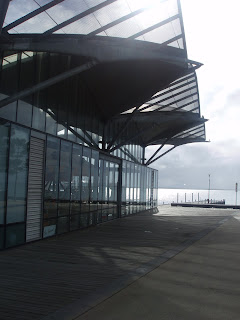 This photo shows the fly bracing used beneath the extruding roof. These braces help to transfer dead loads back to the walls of the building and then down into the footings.
This photo shows the fly bracing used beneath the extruding roof. These braces help to transfer dead loads back to the walls of the building and then down into the footings.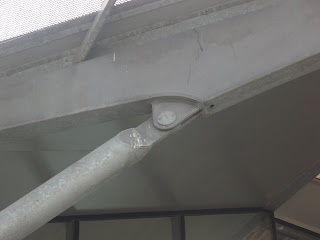 This is a close up of the fly bracings connection to the roof.
This is a close up of the fly bracings connection to the roof. Lastly the base connection of the fly bracing. We can see that 3 steel bracing poles are all extending from the one main column at the corner of the building as this is the easiest place to send dead loads because they will go straight to the footings.
Lastly the base connection of the fly bracing. We can see that 3 steel bracing poles are all extending from the one main column at the corner of the building as this is the easiest place to send dead loads because they will go straight to the footings.
Saturday, May 31, 2008
Major project research / construction

 A very brief sketh undertaken before constructing my model to put my ideas into a visual format is seen above. Below we see step by step pictures of the model i have created, showing how a steel column is connected to the footing. The trench mesh is still visable and would of been in place before the concrete was poured. We can also see the steel reinforcement bars that help strengthen the footing and help protect it under tension forces as well as the steel rods that have nuts attached so as the steel columns level can be adjusted until its even. Finaly we see a small section of what would be a concrete slab coming off the edge of the I beam.
A very brief sketh undertaken before constructing my model to put my ideas into a visual format is seen above. Below we see step by step pictures of the model i have created, showing how a steel column is connected to the footing. The trench mesh is still visable and would of been in place before the concrete was poured. We can also see the steel reinforcement bars that help strengthen the footing and help protect it under tension forces as well as the steel rods that have nuts attached so as the steel columns level can be adjusted until its even. Finaly we see a small section of what would be a concrete slab coming off the edge of the I beam. Foam cut to size before its glued together
Foam cut to size before its glued together Glued together
Glued together Timber to be used as a replacement for a ub column. Cut to size
Timber to be used as a replacement for a ub column. Cut to size
Deformed bar and steel reinforcement bars that are to be used in the model
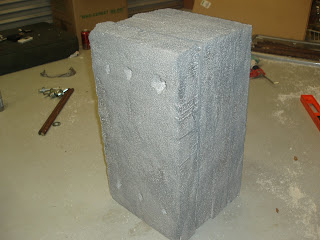








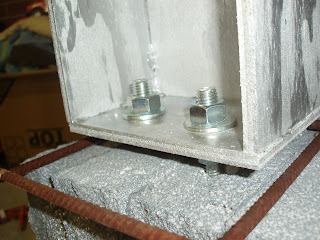
The completed model with a small section of what would be a concrete slab attached to the column.
Construction Article #1
BHP Billiton, the world's biggest mining group, has formally filed with the European Commission for clearance to take over rival Rio Tinto, a Commission list of M&A cases shows.The Commission, the European Union's executive arm and also its antitrust regulator, set a deadline of July 4 for consideration of the deal.By that date the Commission must either approve the deal on competition grounds, open an in-depth investigation, or permit a short extension.Rio Tinto spurned BHP's all-share offer, currently worth more than $US180 billion ($188 billion), shortly after BHP announced it on February 6. The filing was delayed for months during pre-filing talks with the European Commission.
Analysts say the most contentious area is likely to be iron ore, since the combined firm would control around a third of seaborne trade in the raw material for making steel.EU steel firms have vowed to fight the merger, worried a combined group would have undue pricing power over iron ore, contract prices of which have recently increased."We cannot believe that the Commission will authorise the merger of two of three mining companies which are dominating almost 75% of the world market for seaborne iron ore,'' said Gordon Moffat, director general of EUROFER, the European Confederation of Iron and Steel Industries, on Friday.Mr Moffat said Vale is the largest company with one third of the market, and the combined BHP-Rio would have nearly 40% of the seaborne iron ore market."This is not in the interest of the European steel industry'', he said.BHP's bid is a prominent example of a trend in the past few years for metals and mining industry groups to buy running operations rather than start one from scratch.There has also been repeated speculation by analysts that resource-hungry China would put money into BHP as a hedge against rising commodity prices.In the meantime, Rio Tinto has continued to forge ahead with new projects, including the exploitation of the world's next giant iron ore deposit in the company's Simandou project in Guinea.Rio has also moved in to the large gold-copper Oyu Tolgoi deposit in Mongolia by teaming up with Canadian exploration firm Ivanhoe.
Analysis:
This article was published in the age on May 31st and explains how companies BHP and EU have filed to takeover Rio Tinto. The takeover must wait to be approved by commission so to justify it in terms of fair competition in the field of manufacturing steel products, as other companies in the industry are extremely worried about the combined power of the companies leading to price fixing. With so much power in the industry the combined companies could corner the market meaning after they ran smaller companies out of business they could basically charge whatever they wanted knowing that anyone wanting to use steel in their construction would have to pay their inflated prices. ."We cannot believe that the Commission will authorise the merger of two of three mining companies which are dominating almost 75% of the world market for seaborne iron ore,'' said Gordon Moffat, director general of EUROFER. This quote shows the viewpoint of the other companies in the market and it is quite a strong point as it shows that the market will no longer have its competetive nature. This could be a huge blow in terms of construction costs as if the merger is able to go through steel prices will more than likely skyrocket leaving consumers to pay the price.
Completed building visit 1 - Bunnings Warehouse
10 School Rd (cnr Geelong rd), Corio, 3214
This is a perfect example of how portal frame buildings can be used, and is a great choice by the Bunnings company. The best part of using a portal frame in this situation is firstly the shear size that can be built at relitively lower costs than other forms of construction. Secondly, the fact that intrusive supporting colums are not needed means Bunnings can have a big wide open space for their products, as all of the dead loads in the building are diverted to the footings. The main material used in the exterior of the Warehouses is light aluminium. However pre cast concrete panels are used around the perimeter as a base, about 2-3m high.
 An overall shot of the Bunning's Warehouse in Corio.
An overall shot of the Bunning's Warehouse in Corio.
A close up of the pre cast panels previously mentioned. This helps to stop any major destruction that would ruin the aluminium if it went right to the ground.

A long shot showing how portal frames can provide large spaces with no supporting columns. Also we can see cross-bracing is used in this section for extra support on the roof.
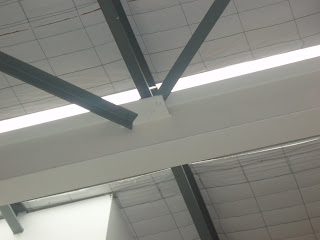
Here we see how the bracing is connected to one of the long span beams.

Finally here we can see how the light is connected to one of the many supporting beams, which is then directed to the main power source. We can also see the insulation and safety mesh on the roof.










